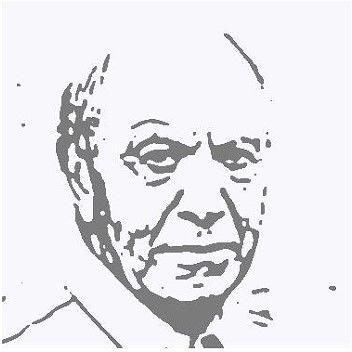Lynn Chadwick
(British, 1914-2003)
Lynn Chadwick was born in 1914 in Barnes, London. His initial desires to become a sculptor were discouraged due to the economic oppression of the 1930s which increased the precarious nature of such a profession. He was consequently persuaded to follow the more practical vocation of architecture. However, during his training, Chadwick became dissatisfied with the theoretical nature of the profession and worked instead as a draughtsman for several architectural practices in London including the firm of Rodney Thomas.
During the Second World War he trained in the Fleet Air Arm of the Royal Navy in the USA and Canada and subsequently became Lieutenant (A) RNVR. He was demobilized in the spring of 1944 and returned to London.
In March 1946 he won a prize in a textile design competition promoted by the textile firm Zika and Linda Ascher which was judged by Henry Moore and Graham Sutherland. He was subsequently offered a contract to design for Linda Ascher which enabled him to move from London to Edge, near Stroud in Gloucestershire where he worked as a free lance designer. During this time he began to make his first mobiles using balsa wood and aluminium wire. These mobiles were intended as decorative features for exhibition stands such as The Aluminium Development Association Stand at the Builders Trades Fair in 1947.
His mobiles were displayed for the first time at the gallery of London art dealers Charles and Peter Gimpel in August 1949. This was followed by a one man show in June 1950. Although Chadwick always viewed his sculptures in architectural terms, Charles and Peter Gimpel regarded them as sculpture and thus reawakened his earlier ambitions.
In a manner characteristic of British sculpture of the post-war period, Chadwick favored the technique of construction to that of carving. His tendency to begin works from an abstract form which he then invests with an allusive vitality is the reverse of more traditional approaches.
In 1952 Chadwick won an honourable mention in the International sculpture competition, Unknown Political Prisoner, which was advised by Henry Moore and Herbert Read. Also during this year he was invited by the British Council to contribute four sculptures and four drawings to a celebrated group show of eight young British sculptors (including Kenneth Armitage, Reg Butler, Henry Moore and Edward Paolozzi) at the XXVI Venice Biennale. The show was characterised by Herbert Read as representing 'the geometry of fear'. Four years later, at the XXVIII Venice Biennale, Chadwick's international reputation was made when, with Ivon Hitchens, he was selected for the British Pavilion and awarded the Biennale Grand Prix for Sculpture.
In 1958 Chadwick bought Lypiatt Park, near Stroud in Gloucestershire, England, which he restored and made his home and studio, and where he is buried following his death on 24 April 2003.

